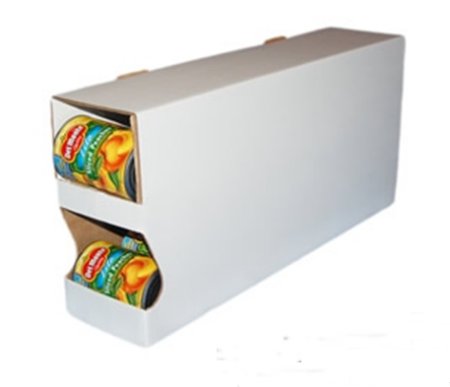
The Pantry Organizer
*A Journey Into FIFO Can Storage*
I have been struggling with our can organization. I have a set of shelves that we are currently using to stack cases of cans on. However, I have been finding that in order to get my MIL to use things, I would need a more user friendly, self-serving FIFO arrangement. My first attempt at modifying the shelf unit was okay, but wasteful. So, after some research I found a product from www.canorganizer.com that I thought might fit the bill. So, I ordered several packages of two different sizes to see how they worked. I must admit to a bit of skepticism at first, as I have dealt with cardboard box/toy assembly in the past. Usually, a lot of hope, but the product fails. Well, while it's too early to really say if this product will hold up over the long term, I do have some hope for it. At just under $16 for a 4 pack of the boxes that will hold about 16 20oz can of veggies each, it was at least 1/2 the price of some of the plastic racks I found that held similar quantities. Please bear in mind that this was not a fully qualified, college funded, research project; however, I did look around!!
What I ordered:

The Pantry Organizer
1 unit will hold:
Dimensions
Capacity: Up to 39 per unit or 156 per 4 pack depending on can size.
Cost: $15.96 for a 4 pack. Shipping is expensive due to the weight; however, if you buy 5 or more packs you get a 10% discount. So with my shipping, it cost me $5.27 per unit. Not too bad.
So, what about the boxes, you ask? Well, in short, they work. The units come packaged flat and wrapped in shrink wrap via UPS ground. When I got mine, some of the corners were a bit bruised but not badly and certainly nothing of a nature that would prevent usage or promote early failure. The individual units are die-cut and stamped for assembly. The instructions are printed on each unit on a part that is removed to assemble. The first unit to assemble is a bear. The instructions are not immediately clear; however, once you have done one you have an "AH HA! Moment" and it becomes much easier. There is an instructional video on their website that I encourage you to use prior to assembly. Additionally, it became abundantly clear that 4 hands were better than 2. Sit down at the kitchen table and have someone help you do each one. It really will go faster if you both work on one, rather than each of you working separately. And like I said, once you have your "AH HA! Moment", they are easy to assemble. Just make several folds and tuck a couple of tabs into slots. My only concern is how reliable the joinery where you insert the tabs will be long term. If these were being loaded and unloaded frequently, I could see them giving out. But as long as they are fairly tight against each other on the shelf, I think there are probably years of service here. Obviously, the usage life time will go down if they get wet. I only made one modification to the process and that was to add 3 strips of Duct tape along the areas where the tabs inserted to hold the assembly together...this was my hedge against my reliability concern. If you get these, it will be immediately clear where to place the tape.
The overall result is, on my shelves, with a standard 4' x 2' shelf, I can get 7 of the fully assembled boxes on one shelf. That holds approximately 106 cans depending on the size of the can. The reality of this is as follows: I lost capacity! If I stack the cans without the boxes, and stack them 2 or 3 high, I can fit a WHOLE lot more. But the organization and usage is intolerable. There is no realistic way to rotate the cans effectively. Placing new stock is blocked by the old stock. But I knew there were going to be trade-offs. I needed organization to fit my existing structure and this system provides it. Overall, I think I am happy with the results. Time will tell how the boxes will hold up. I will update this as I get more usability data.
Baldie
www.alpharubicon.com
All materials at this site not otherwise credited are Copyright © 1996 - 2012 Trip Williams. All rights reserved. May be reproduced for personal use only. Use of any material contained herein is subject to stated terms or written permission.